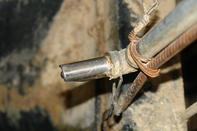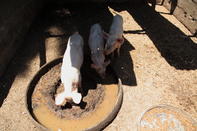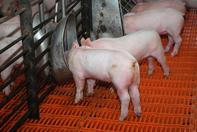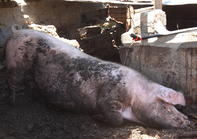
Water Quality
Water quality should preferably be tested annually, so corrective measures can be taken if necessary. The source of water often determines the quality and suitability of the water for pigs, be it dam, municipal or borehole water. The following should be analysed:
The bacterial count: Chlorine treatment is recommended if the bacterial count is high. Remember that dirty water lines and drinkers may exacerbate bacterial problems, so it is important to regularly flush and clean drinkers and water lines.
Acidity: Water pH levels should range between 5 and 8. Anything above or below this, may affect water intake and be potentially harmful. Water that is too acidic (below 5), may also cause corrosion and damage pipes and water lines, whereas water that is too saline may leave scaly deposits that obstruct pipelines and drinker, requiring more frequent flushing of lines.
Hardness: Calcium and magnesium are the predominant minerals that can make water “hard”. A water softener may be used to soften the water.
High nitrates, sulphates and other minerals: The pig diet should be adjusted to accommodate high levels of specific chemicals and minerals. Water might also have to be filtered or treated before it can be supplied to the pigs, which under some circumstances may render production unprofitable.
Volumes Required

The volumes of water needed daily depend on many factors, including climatic conditions, feedstuffs, the health and production stage of the pig as well as the type of drinkers used.
In extensive production conditions, a pig may need at least five to ten litres of water every day, whereas daily water needs may range from below 2 litres per pig per day for newly weaned pigs to more than 6 litres per pig per day for grow-finished pigs using nipple drinkers.
Sows feeding young need to drink even more water to produce sufficient volumes of milk, with their water requirements ranging between 15 to 32 litres per day on a nipple drinking system, while the water requirements of gestating sows ranges from 12 to 15 litres per day.
Other Considerations

Mud Baths

Few farmers still provide their swine with mud pits, but it has been found to help with temperature regulation. It can apparently lower a pig’s temperature by about 2 degrees Celsius, making it even more efficient than sweating which is difficult for pigs as they do not have any sweat glands.
Wallowing in mud also helps to keep parasites, such as ticks and lice in check, but should not be seen as a substitute for treatment when problems arise. In addition, wallowing in the mud is a natural animal behaviour, which some people see as a contributor to animal welfare.
By Glenneis Kriel